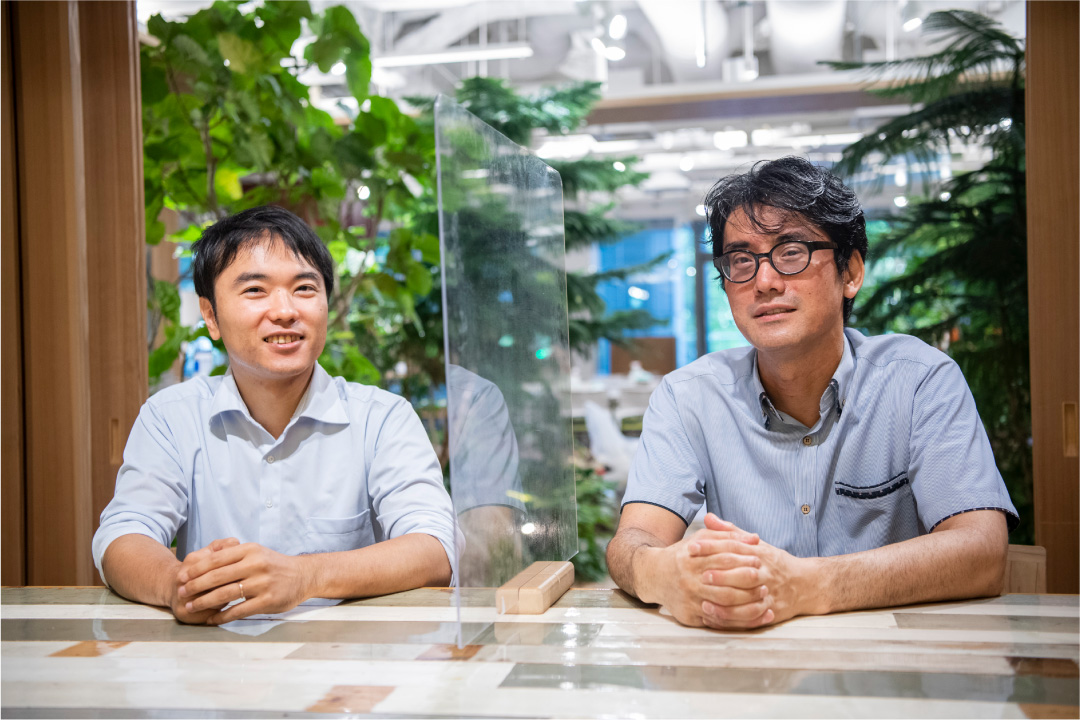SUSTAINABILITY
Interview
Urban development that shares the allure of greenery and passes on the abundant nature of Marunouchi to future generations
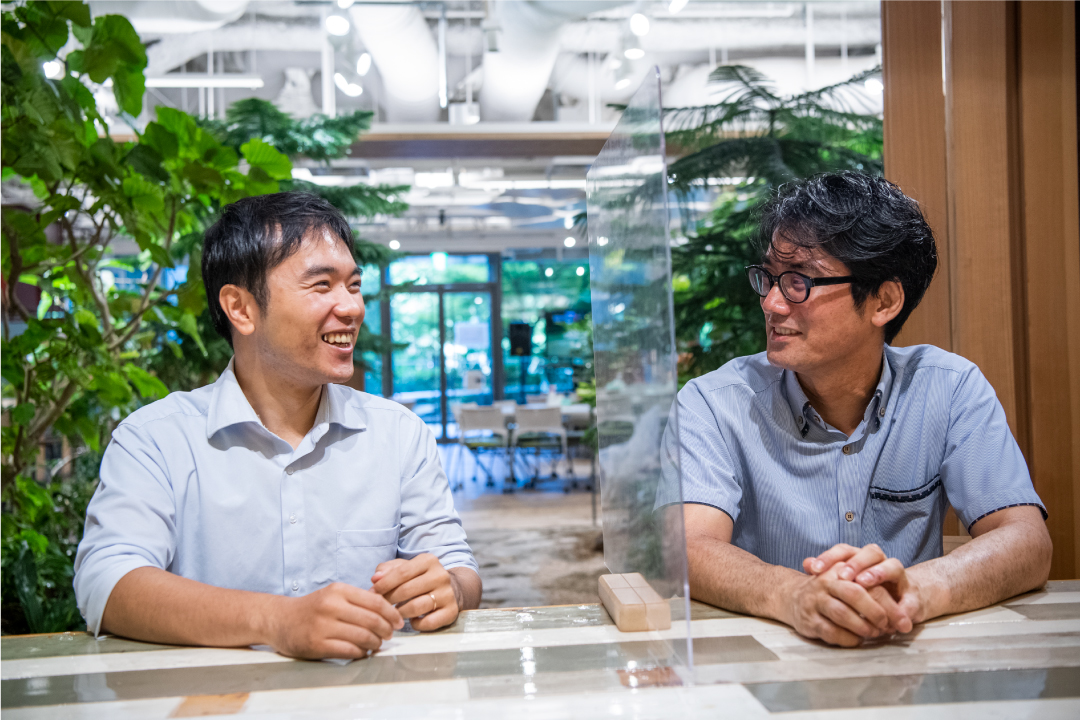
Hirotaka Matsui (Left)
Environment/R&D Director
Ecozzeria Association (The Association for Creating Sustainability in Urban Development of the Otemachi, Marunouchi, and Yurakucho Districts)
Environment/R&D Director
Ecozzeria Association (The Association for Creating Sustainability in Urban Development of the Otemachi, Marunouchi, and Yurakucho Districts)
Daisuke Mitatezaka (Right)
Senior Manager
Promotion Unit
Sustainability Management Promotion Department
Mitsubishi Estate Co., Ltd.
Senior Manager
Promotion Unit
Sustainability Management Promotion Department
Mitsubishi Estate Co., Ltd.
The proximity of the Marunouchi area (In this context, the term “Marunouchi” refers to “Otemachi, Marunouchi and Yurakucho”) to the gardens of the Imperial Palace means it benefits from an abundance of nature. To pass on this flourishing environment to future generations and share the allure of greenery with more people, the comprehensive real estate developer, Mitsubishi Estate Co., Ltd. and the Ecozzeria Association, which tackles environmentally symbiotic urban development, are carrying out activities that leverage each of their strengths. Two persons key to these activities spoke about these endeavors at 3×3 Lab Future (Otemon Tower ENEOS Building), a unique venue run by the Ecozzeria Association.
Marunouchi's natural environment is loosely interlaced with the Imperial Palace gardens
━━━
How do you feel about the natural environment that surrounds the Marunouchi area?
Mitatezaka:
Marunouchi is an area located between the main terminal of Tokyo Station and the Imperial Palace. While there is a sea of buildings around Tokyo Station, the Imperial Palace is an invaluable treasure trove of nature in the city center. Since Marunouchi is flanked by both environmental extremes, the wildlife that lives in the Imperial Palace flows over into Marunouchi. The area has a unique ecosystem where we can see endangered species of dragonfly and black-headed gulls migrating in winter in this urban center.
Matsui:
I also feel that overflow of nature. Being able to appreciate an abundance of nature in central Tokyo through that loose interlacing with the greenery of the Imperial Palace is a characteristic of this area. As someone who works in Marunouchi, I feel the appeal of an environment that lets me easily enjoy scenery by glancing out the window and nature that is accessible just by stepping outside
Mitatezaka:
I think you can call the area around Otemon Tower ENEOS Bldg., where this 3×3 Lab Future is located, and the neighboring Otemachi Park Bldg. an especially fortunate environment within the Marunouchi area. Between the two buildings is Hotoria Square, an approximately 3,000 square meters of green land. “Hotori” means ‘by the side of,’ and as the name says, the square is next to the outer moat of the Imperial Palace Outer Garden. As the site of an ecological network*1, Hotoria Square has received ABINC certification*2 in recognition of creating of a space where people and living creatures can converge. This includes reflecting the vegetation in the Imperial Palace in the greenery.
*1
A network of ecosystems that links various spaces where wildlife lives and grows
*2
A certification system from the Association for Business Innovation in Harmony with Nature and Community (ABINC)
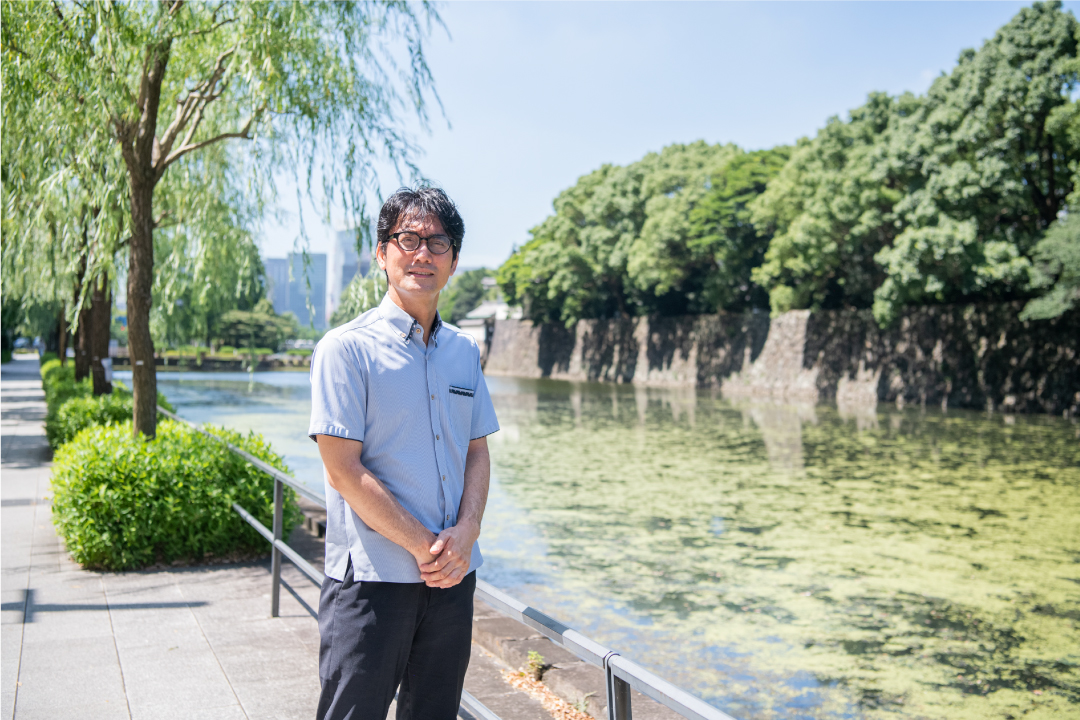
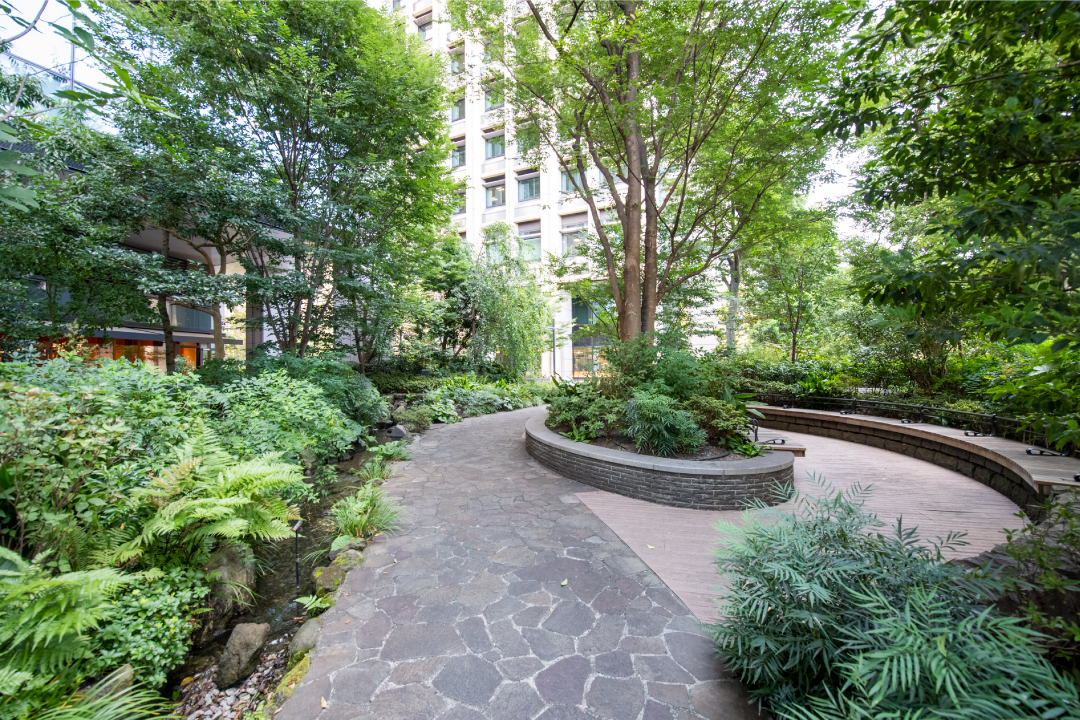
Hotoria Square
The Moat Project: The challenge of restoring the wildlife of the Imperial Palace moat
━━━
Since 2018, Mitsubishi Estate has been working on the Moat Project, which protects biodiversity in the moat. Please tell us what led to the project and the kinds of activities it entails.
Mitatezaka:
The Moat Project*3 was started in collaboration with the Ministry of the Environment. It's the first private-sector business endeavor that takes up the challenge of bringing back the living creatures that originally existed in the Imperial Palace moat. Water quality worsened after the water flow from the Tama River ceased in 1965, and although our company has been helping improve the waterfront environment, including installing a water-cleaning facility for the moat in the basement of the Otemon Tower ENEOS Bldg., the Moat Project is an endeavor that can be said to go a step further. It collects endangered water plant species, small living creatures, and mud and cultivates them in biotopes*4 on the roof of our company's building and Hotoria Square.
Matsui:
When I first heard of the Moat Project, I was excited at the challenge of bringing back rare species and passing them on to future generations. The endeavor is in itself unique, but its method of approach that incorporates various people and organizations also has value. Rather than being carried out by Mitsubishi Estate alone, it's a collaborative effort among government, NGOs, and specialized agencies. I believe many ordinary people have also participated in collecting wildlife at the moat and introducing them to Hotoria Square.
Mitatezaka:
That's right. People of all ages have participated, particularly those who work in Marunouchi and their families. Mitsubishi Estate owns many buildings in this area and engages with these people in various ways. We also hope to boost the communication of information so that a greater number of people will become interested in urban ecosystems and natural environment through the project.
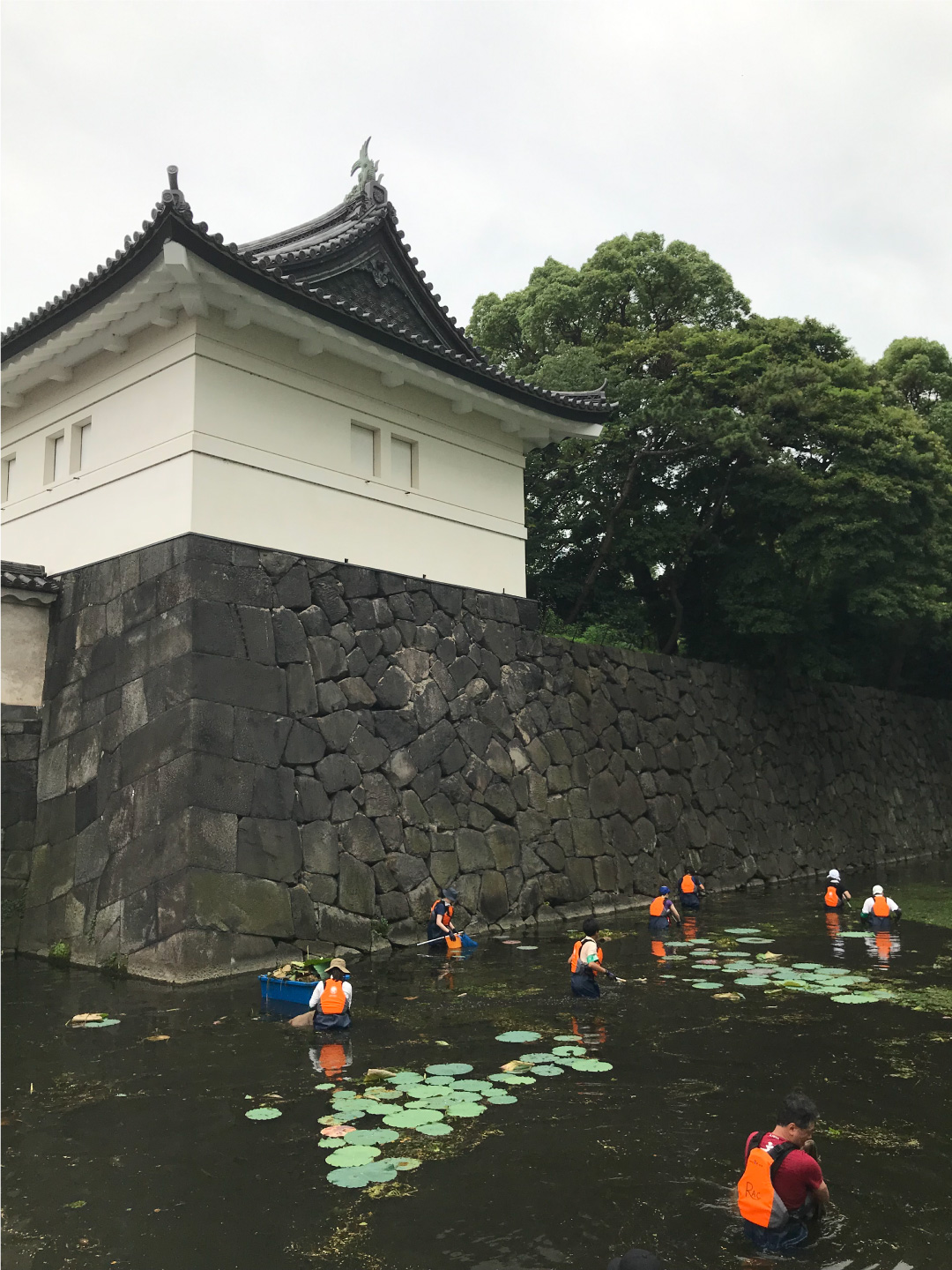
The Moat Project
━━━
You've also been successful at restoring water plants found on the list of wildlife species threatened with extinction (Red List).
Mitatezaka:
When the collected mud was placed in an environment managed in the experimental site in Hotoria Square, seeds that had been dormant sprouted, and the water plant, Mizohakobe (waterwort) that no longer lives in the moat was revived. The seeds in the mud also included three species of rare water plants on the Red List in 23 Wards of Tokyo.
Matsui:
When seeds are dormant for a long time, they eventually die. I think it's extremely valuable that they were moved to a different place and an environment was created so they could sprout.
Mitatezaka:
Now they're being safely cultivated at the biotopes, but at first it was difficult. We were truly lucky to have found endangered species since we didn't know at first if there were any seeds in the mud. Not knowing what kind of environment these kinds of delicate plant species preferred, we had to fumble through everything including pH, managing water temperature, and adjusting water current.
Matsui:
3×3 Lab Future brought in water plants that actually grow in the Imperial Palace moat and displays them in a tank modeled after the moat. Together with the biotope at Hotoria Square, it's become a place that can share the moat's ecosystem with a wide range of people. I think it's important to be able to actually view the wildlife in order to also properly communicate the significance of the endeavor.
*3
Based on the Agreement on Natural Resource Utilization in the Imperial Palace Outer Garden concluded with the Ministry of the Environment, activities for the Moat Project are being promoted together with the Nature Conservation Society of Japan, the National Institute for Environmental Studies (NIES) Center for Climate Change Adaptation (CCCA), and the Natural History Museum and Institute, Chiba.
*4
Refers to a space that restores an ecosystem lost through the advancement of industry, urbanization, etc. so that wildlife that originally existed in that region can live.

A tank displayed at the 3×3 Lab Future
The online service, TOKYO OASIS visualizes the allure of greenery in Marunouchi
━━━
The Ecozzeria Association is involved in operating TOKYO OASIS, which is an online service that can be used to enjoy outdoor walks in Marunouchi. Specifically, what kind of undertaking is this?
Matsui:
Marunouchi is striving for urban development that nurtures greenery throughout the area in both hard and soft infrastructure, such as the Moat Project. TOKYO OASIS is a service that visualizes the allure of greenery so that it can be enjoyed. Sites in the Marunouchi area where people can enjoy the outdoors are listed as OASIS SPOTS. Users can easily search for a route to those spots on a smartphone and enjoy a pleasant walk outside. The service was launched on a trial basis in the summer of 2020, and new functions were added based on comments from people who tried the service. A field test was again started in July 2021. The service is available in five languages and can immediately be used without having to register or install an app. It can also be readily used by inbound tourists who are visiting.
Mitatezaka:
TOKYO OASIS is based on the Marunouchi Environment Atlas, an information platform developed by the Ecozzeria Association that turned environmental information on the Marunouchi area into a database. It digitalized hourly information on shade cast by street trees and buildings. I think this upgraded version is distinctive for including places to sit down and information on individual trees in the area.
Matsui:
When developing the service, we paid careful attention to how to handle the various ideas people have regarding ‘enjoyment.’ For example, we prepared three routes to OASIS SPOTS, one for shady sites, one for sunny sites, and one for the closest site. At first, we focused on summer routes offering shade that hinged on ‘coolness,’ but the meaning of ‘enjoyment’ isn't fixed even for the same person. For instance, people may want to walk in the sun even in summer after having been in a cool, air-conditioned place for a long time. We want each individual to find comfort that suits them by choosing to use the service. In addition to Hotoria Square that was mentioned earlier, OASIS SPOTS include places to relax, open spaces, and parks.
Mitatezaka:
Hotoria Square has become a place for each person to relax in their own way. They can take a short walk, rest, or have lunch there. The purpose of Hotoria Square is precisely to be a pleasant environment for both people and living creatures.
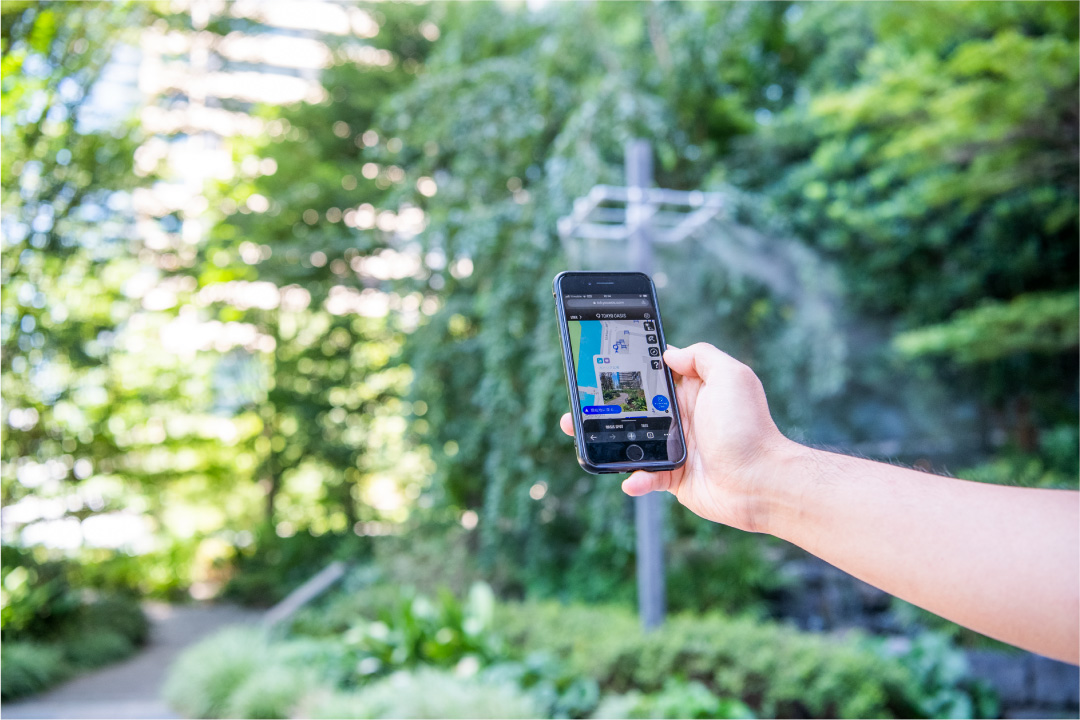
━━━
What kind of role do you think greenery plays in urban development?
Matsui:
I think the attraction of greenery is not only plant life such as trees, but everything it encompasses such as the environment and spaces the greenery creates. TOKYO OASIS reflects the shade made by trees in the shady routes, and by surveying each of the approximately 3,500 trees in the area, it introduces information like the tree species and heights, as well as the amounts of CO2 absorbed and carbon storage. In the background is the idea that the love for greenery, which is part of the attraction of Marunouchi, will grow through users learning about the role of trees.
Mitatezaka:
The role of greenery in decarbonization is extremely important. On that point, as a new initiative our company is starting a biomass power generation project that utilizes street trees. This project reuses branches from street trees that have been pruned for maintenance as fuel for biomass fuel generation with the aim of producing regional recycling-oriented power generation using renewable energy. There is also a plan to use the pruned branches from trees introduced in TOKYO OASIS in this way in the future. Marunouchi is an area that has succeeded in an advancement of symbiosis with nature not seen elsewhere in the 23 wards of Tokyo. Greenery has become an element of people's well-being in various aspects. In day-to-day settings as well, people's impressions of the area will greatly change because of an abundance of trees and plants.
Matsui:
I feel exactly the same way. Marunouchi is an area visited by many people through MICE events. In that case, they likely spend a lot of time in meeting venues. Even so, we want them to have time to walk outdoors and experience the charms of the area. I think an environment where people can feel greenery close by and relax also helps meetings and events proceed smoothly. I certainly want MICE participants to walk outside in Marunouchi and feel refreshed.
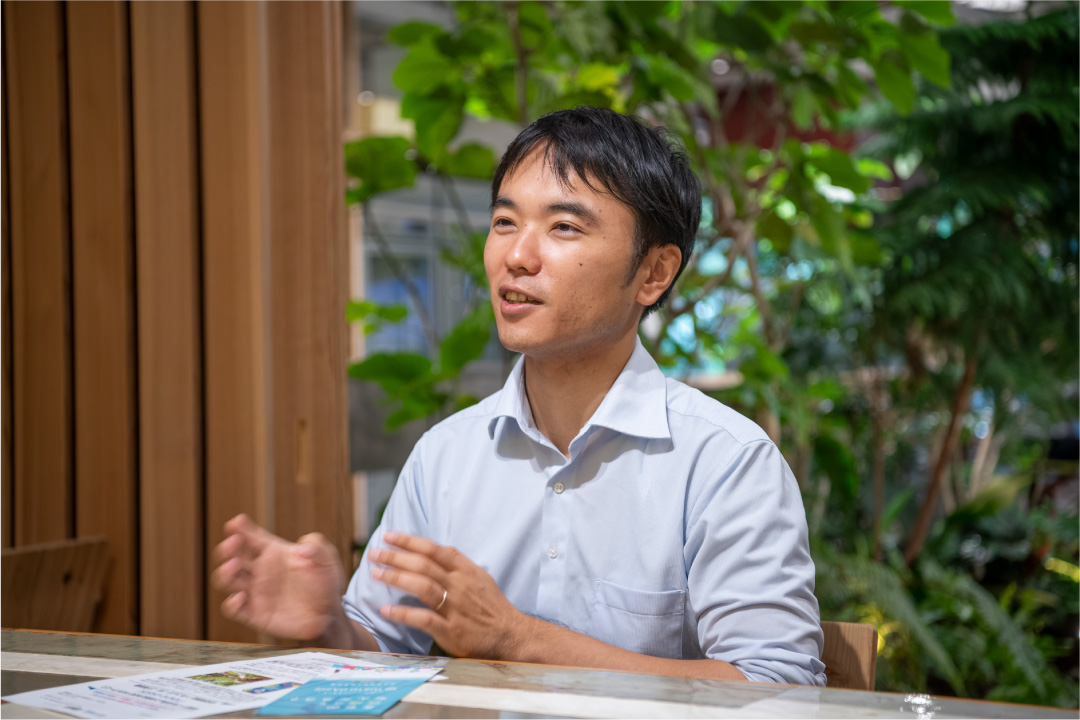
Aiming for a vibrantly radiant future for both people and nature
━━━
Please tell us what's happening with TOKYO OASIS and the Moat Project going forward.
Matsui:
The field testing for TOKYO OASIS has just started. To continue considering what constitutes an enjoyable walk outside, we intend to gain more feedback from users to bring together Marunouchi and people, which will lead to discovering new attractions and value in the area. For instance, it would be great if the service could visualize the allure of the changing four seasons by suggesting places to go to in different seasons, such as places fragrant with flowers and where migratory birds can be seen.
Mitatezaka:
In the Moat Project, going forward our company will work to increase spaces like Hotoria Square through other development projects. Finding optimal solutions isn't simple, since site conditions and development concepts differ for each building, but we're searching for such approaches as ways to leave behind diverse wildlife for future generations. It would also be ideal if we could collaborate with other area businesses to tackle creating such spaces together instead of going it alone.
━━━
In what way do you want to energize Marunouchi through sustainability initiatives?
Matsui:
Matsui: The Ecozzeria Association is working on other endeavors to communicate the attraction of greenery in addition to TOKYO OASIS. The nature program called Shizen no Copain (Nature's Friends) offers opportunities for people to connect with nature and others by looking at nature in a new way. Plus, we've joined the executive committee for the Marunouchi Honey Project, which collects honey produced in Marunouchi, in an effort to build a community and energize the area through activities entailing beekeeping, commercialization of honey, and sales. Through these various activities, we hope that Marunouchi is accommodating to both people and nature, and becomes an area where that interconnection is apparent. We also aim to take action by cooperating with various bodies including government, companies, and groups to increase the quality and amount of greenery that reaches beyond the Marunouchi area, which is interlaced with the greenery of the Imperial Palace, by forging further connections to greenery in other surrounding areas.
Mitatezaka:
There are many approaches to promoting sustainability, but I believe the ultimate goal is to create circumstances where people, organizations, trees, living creatures, and all things can live vibrantly. We intend to steadily move forward one step at a time, contributing what we can, toward that goal.
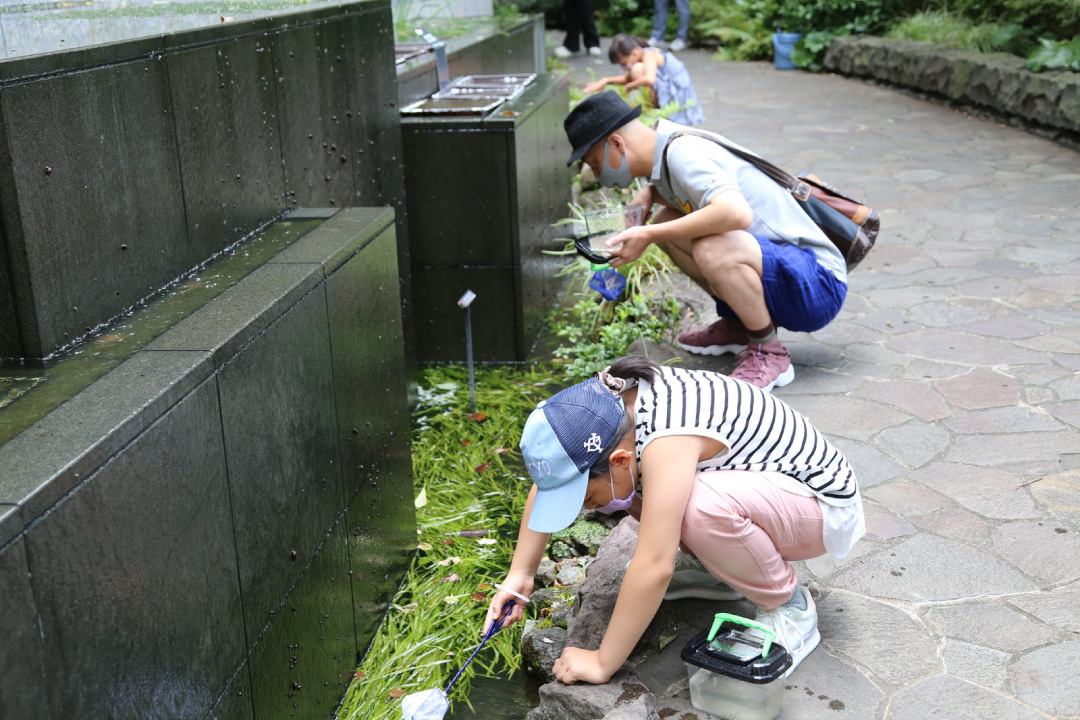
Strolling the Hotoria Square during the program of "Shizen no Copain"
